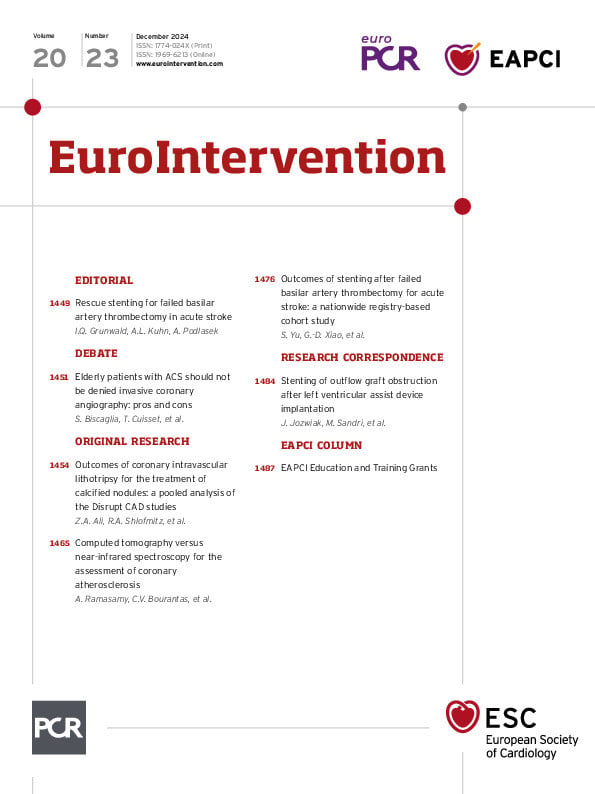The study led by Shuai Yu, in this issue of EuroIntervention, is a valuable contribution to the evolving field of stroke intervention, particularly in the context of rescue intracranial stenting (RIS) for basilar artery occlusion. This paper demonstrates the feasibility and safety of RIS despite its clinical outcomes not showing improvement, which may well be due to the inherent complexities and limitations of the study design and patient cohort1.
One of the primary challenges in treating basilar artery occlusion lies in the variable clinical presentations, with patients displaying mild, moderate or severe stroke symptoms leading to a wide range of National Institutes of Health Stroke Scale (NIHSS) scores.
This stroke type is also notorious for its difficulty in establishing an exact time of onset, as posterior circulation strokes frequently present with stuttering symptoms, sometimes spanning days before the actual diagnosis. These nuances complicate the accurate assessment of RIS effectiveness due the variability in recorded severity and stroke onset-to-recanalisation time.
Additionally, the anatomy of the posterior circulation is highly variable, and the outcome of endovascular interventions depends heavily on the collateral circulation and the underlying anatomical structure of the patient.
The higher incidence of symptomatic intracranial haemorrhage (sICH) in the RIS+ group compared to the RIS– group is noted, even though, after adjusting for confounding variables, no significant correlation was found between RIS and sICH. Here, in addition to intravenous thrombolysis, future studies may wish to record some additional key factors, such as antiplatelet or anticoagulation regimens and blood pressure management. Also, the number of patients who experience stent thrombosis will impact outcome, so results from platelet aggregability testing or genotyping should provide valuable information.
This research encourages further exploration into optimising treatment strategies and patient selection for these challenging cases. Given the significant variability in the patient cohort, it is doubtful if a randomised trial would be a suitable approach for future studies on this topic. The complexities of basilar artery occlusion, from anatomy to assessment of viable tissue at the time of treatment, make it challenging to standardise. Instead, this paper highlights the benefits and further need for a well-designed registry that takes into account additional crucial covariables such as collateral circulation, anatomical variability, thrombus location, blood pressure, the likelihood of viable tissue at the time of stent placement and stent patency, antiplatelet/anticoagulation regimens, platelet aggregability testing, genotyping, and the critical time from initial imaging to the end of the procedure. Going forward, the complexity of posterior circulation stroke demands a nuanced approach.
The study’s results should not be seen as a limitation of RIS itself but rather as a reflection of the intricacies involved in treating posterior circulation stroke. RIS did not lead to worse outcomes, and this positions RIS as a viable option when thrombectomy is unsuccessful.
In conclusion, we commend Shuai Yu and colleagues for their significant contribution to this challenging area of stroke intervention. The insights gained from this study pave the way for more informed clinical decision-making and improved treatment strategies for patients with posterior circulation stroke. With more comprehensive data collection and future research, we may yet see RIS emerge as a standard option for these highly complex cases, offering hope for better patient outcomes in scenarios where thrombectomy falls short.
Conflict of interest statement
The authors have no conflicts of interest to declare.

